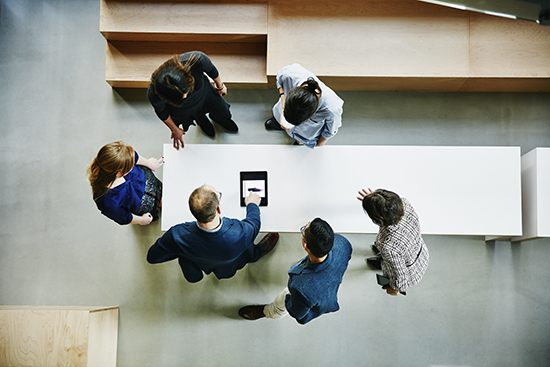The future of retailer technology is in development
Retail stores meet online experience
Digital leaders are threatening traditional retail models by reinventing the store experience.
The growth in ecommerce is continuing to impact on the traditional store, and whilst some retailers have not been able to adapt, others are becoming increasingly creative in how they leverage the physical bricks and mortar channel. Online native merchants are also now investing in a physical presence to extend and enrich their propositions, increase consumer engagement, and raise the profile of their brands.
Most recently, there is the Amazon 4-star shop in New York – this enables customers to discover and experience products first hand – to use, touch and feel before buying. The store offers a heavily curated product range which is regularly refreshed and powered by the underlying data and analytics provided by the core online platform. The store includes customer reviews, rich product information, what’s hot locally, and the ability to pay using the Amazon Pay app.
China is a hot bed of innovation in this space, with the previously online only giants Alibaba and jd.com launching the Hema and 7Fresh supermarket experiences respectively, employing technologies like facial recognition for payment and autonomous shopping carts that follow you around the store, and the option of a 30-minute delivery to home where your instore shopping is transported by aerial conveyor belt to a transportation hub at the rear of the store for onward despatch.
Technology is at the core of the new retail experience
Since the arrival of ecommerce and online web platforms we have seen an exponential rate of evolution of the technologies in use. However, store-based technology has seen nothing like the pace of evolution of the online world, although there are signs are this is starting to change as retailers strive to create a compelling reason for shoppers to visit and engage.
The emergence of digital technologies such as AR/VR, Machine Learning & AI, IoT etc. has enabled the realisation of experiences in the physical world that were not previously possible.
An obvious example of this being the Amazon Go checkout-less store – using a combination of cameras, sensors, and machine learning to determine what products a customer has picked up, and automatically charging their Amazon account upon leaving the store. In the Netherlands, grocer Albert Heijn has developed a similar experience with their Tap-to-go solution which employs NFC cards & smart shelf labels, enabling customers to build a virtual shopping basket with payment taken automatically after 10 minutes. In the UK, both M&S and Sainsbury have also recently launched comparable propositions.
Additionally, technologies that have previously met with limited success are now being powered by working in concert with these more recent innovations – Electronic Shelf Edge Labels in store can now power near real-time price changes, rich content and customer reviews, or even personalised pricing, mimicking the online world. A great example of this is the pilot interactive ‘EDGE’ shelf solution recently launched by Kroger following joint development with Microsoft.
RFID, in addition to the established inventory tracking use case, is now being explored as part of smart checkout or smart fitting rooms to improve the customer experience, or as a data source for a blockchain implementation to enable nonrepudiation and traceability in the supply chain. As recent Accenture research has revealed, this is particularly prevalent in North America where in a survey of retail executives 92% of those surveyed reported they are progressing to RFID adoption, whereas European retailers are lagging behind at 30%.
Bespoke development is making a comeback
Customer expectations will likely continue to grow – what is new / differentiating today will be commonplace tomorow, and as the examples above show, technology is increasingly a core part of how these are met. Delivering breakthrough, truly innovative technology-based solutions is not possible with off the shelf products, and companies like Amazon and Alibaba have the capabilities to build their own solutions. Therefore, to compete you will need to do the same through an increase in bespoke software development – either in-house or via partnerships and acquisitions.
This certainly doesn’t represent a move to ‘build everything’ – core operational systems are typically low in change velocity, and even at the edge there are some solutions ready-made which “just work” and it would make no sense to redevelop them.
However, modern techniques make development of bespoke software a much more viable undertaking;
- An abundance of reusable libraries, open source software and PaaS (Platform as a Service) means it’s not necessary to write everything from scratch, reducing the time and cost of development.
- Agile, DevOps methodologies typically result in a faster speed to value and more aligned, relevant, fit for purpose solutions from closer business / IT collaboration.
- The ability to connect solutions through API’s makes integration and composition of private and public services and components into complete solutions easier than it’s ever been (although by no means plug and play!).
In summary, with the pressure to innovate at speed increasing, and the cost and challenges associated with software development reducing, the option to build bespoke has become a more attractive and feasible proposition.
Conclusion
Today if you want to be leading in store experience, or even just to keep up with strong performers – you need to have a digital/modern software engineering capability to support business innovation. This has implications on Retail IT organisations that aren’t already evolving in this direction. New software development techniques must be learned and adopted, and the IT operating model needs to adapt to support the accelerated pace required.
Is your Retail IT organisation ready for the future?
